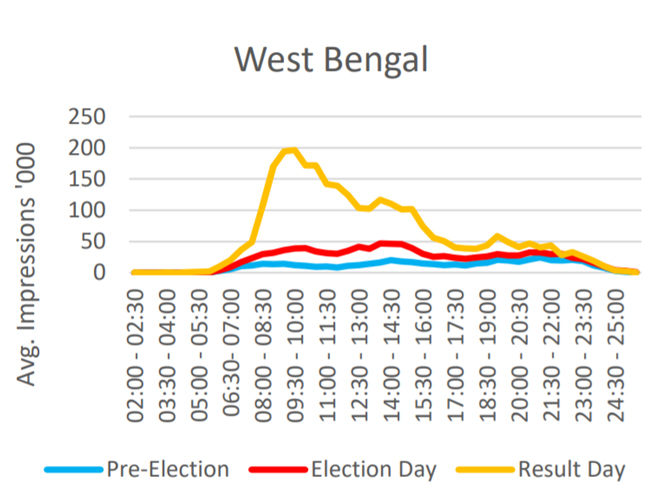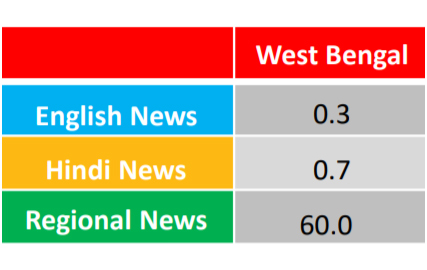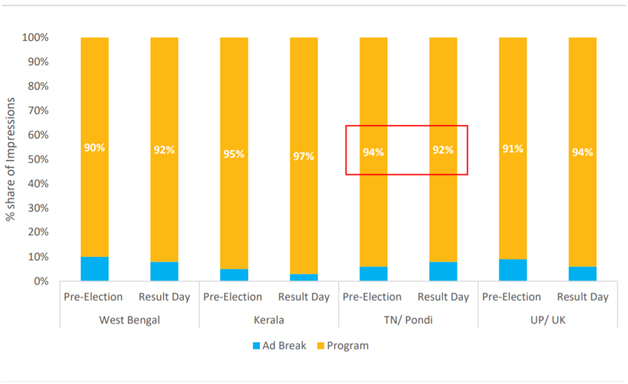NEW DELHI: West Bengal has turned into a veritable battleground now; as the state gears up for its 17th assembly elections, the political heat in the state is unprecedented. The outcome of the three-cornered fight between Trinamool Congress (TMC), BharatiyaJanata Party (BJP) and the alliance of Congress and Leftwill have a significant impact on politics across the country. It will also set the tone for other state elections that are slated to happen throughout the year.
The upcoming polls have fired up news television networks in the state, for the past few months saw Republic Network and TV9 Network joining the fray with their own Bangla-language channels. More established players like ABP Ananda, Zee 24 Ghanta, and the regional giants have also created a robust content strategy that will span the run up to election day and the results, expected to happen in April-May. The ad market is also reacting fast to the developments, and despite the absence of BARC viewership data to rely on, advertisers are eagerly putting their monies on election coverage specials, several industry experts told Indiantelevision.com. However, regional channels will be winning big when it comes to viewership during the polls.
Six of the top 10 news channels in West Bengal are Bengali news channels and four are Hindi news channels. English news channels do not feature in the list of the top channels. If we look at the 13 week average of news viewership in West Bengal among AA 15 yrs+ (prior to the ratings being stopped by BARC), ABP Ananda, Zee 24 Ghanta and Kolkata TV featured on the top three slots amongst news channels.
OMD Mudramax EVP and principal partner Navin Kathuria shared that the state has emerged as a strong regional market in the past few years and the preference for Bengali content there has increased substantially. “Preference in West Bengal is skewed towards Bengali content. Bengali channels across genres account for almost two-thirds of the TV viewership. The trend is replicated for the news genre too. Even in the non-election period viewership of the Bengali news genre is almost 2X of the Hindi news genre. For the period preceding just before BARC ratings for news channels were stopped, Bengali news genre garnered five-seven per cent of the West Bengal viewership whereas Hindi news genre managed two to three per cent share.”
Given thatstate elections are one of the most important events for the region and the people, viewers will prefer watching election coverage on regional / Bengali channels. The reasons could be multiple, he explained – a detailed and prudent analysis of local issues, better coverage, perception of regional channels being closer to ground realities etc.
The Media Ants co-founder Samir Chaudhary added that viewership is expected to spike as much as 30-40 per cent during the assembly elections, with regional language news channels taking the biggest share of the pie. “Even during the recently concluded Bihar elections, the trend was similar. It won’t be surprising if the West Bengal news market surpasses even that number, as the political environment is more charged there than ever and the whole nation is paying key attention to it. It won’t be easy for us to share the data on the pre-election trends as we are not getting it from BARC, however, I am positive that it must have spiked.”
The historical data supports these assumptions. According tothe BARC News Story 2018 report, election coverage witnessed a huge uptick in viewership during the 2016 assembly polls in West Bengal, the biggest surge being on the result day. The state had higher numbers of viewers tuning in during the morning slots.

In terms of language, the average impression on regional language news channels in West Bengal was 60,000 on election result day, as compared to 700 on Hindi and 300 on English news channels.

Kathurianoted, “The viewership rise is primarily on the regional channels of the state in which the elections are being held, national channels in other parts of the country do not show a significant spike. If we look at Maharashtra elections in October 2019, Marathi news channels witnessed a 45-50 per cent increase in GRPs during the election period and a few weeks post the election, but Hindi / English news channels in other parts of the country did not see any significant change in viewership. The same trend is observed for the Delhi elections in February 20. Hence a steep increase in national news channels viewership is not expected.”
He, however,went on to add that the rest of the nation may be keenly watching the Bengal polls this time around. “West Bengal elections this time are a little different – BJP made significant gains in the state in Lok Sabha elections in 2019, elections are being conducted after a tough pandemic year, political turmoil in West Bengal has created a lot of ripples nationally etc, hence viewer interest in WB elections across other parts of the country might be a notch higher as compared to other state elections held in the past. This might benefit the national news channels in terms of marginally increased viewership.”
In terms of ad volumes, the 2016 West Bengal election coverage shows ads taking up 10 per cent of the programming space during the pre-election phase, which reduced to eight per cent on result day.

Stating this year’s trends, Kathuria shared, “While quantitatively the number of ad slots will remain the same, but there is a lot of election specific special programming content on all the Bengali news channels. Around 30-50 per cent of news content during this period will be election-based. While it’s definite that the news channels will earn more than the average advertising revenue, putting a number to it becomes tricky.”
While the ad rates will vary from channel-to-channel to during the period the advertising on these programmes will with a premium over the regular news slot ad rates. As per industry estimates, the top regional-language news channels are selling their inventories for a price of Rs 2,500-3,000 on an RODP basis, for each 10-second ad, while prime time must be costing around Rs 6,000-7,000. The latter will reach Rs 10,000 on poll days and even higher on result day. The overall inventory rates, for most channels will go up by 30-40 per cent.
In Kathuria’s view, there isn’t going to be any demarcation of categories or brands that will advertise especially during election season. “As seen in trends in the specific market where the election is being held, news channels garner higher eyeballs, and hence all advertisers/brands which have West Bengal as a priority market will like to cash inon the elections. Having said that the conventional categories targeting male audiences will be primarily present – automobiles, financial services, construction materials, consumer electronics, mobile phones etc.”






